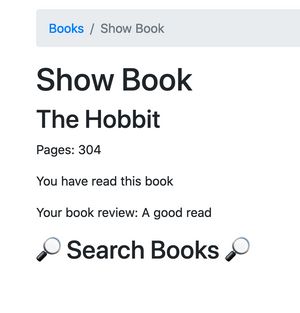This is part 3 of the series IHP with Elm
We have set up a single widget and most of our logic lives in a single Main.elm file.
Since we are planning on creating an application supporting multiple isolated widgets, we might as well split this application into smaller more maintainable sub-modules with their own seperate model, view and update functions.
A simplified version of Richard Feldmans's RealWord Example app is a great architecture for this use-case.
Separating the BookWidget module
Inside the elm folder, let's create a sub-folder named Widget, and a module inside named Book.elm
mkdir elm/Widget
touch elm/Widget/Book.elm
Let us extract all the relevant logic into elm/Widget/Book.elm.
module Widget.Book exposing (..)
import Api.Generated exposing (Book)
import Html exposing (..)
type alias Model =
Book
init : Book -> ( Model, Cmd msg )
init book =
( book, Cmd.none )
initialCmd : Cmd Msg
initialCmd = Cmd.none
subscriptions : Model -> Sub Msg
subscriptions _ =
Sub.none
type Msg
= NoOp
update : Msg -> Model -> ( Model, Cmd Msg )
update msg model =
case msg of
NoOp ->
( model, Cmd.none )
view : Model -> Html Msg
view book =
div []
[ h2 [] [ text book.title ]
, p []
[ text "Pages: "
, book.pageCount |> String.fromInt |> text
]
, p []
[ text
(if book.hasRead == True then
"You have read this book"
else
"You have not read this book"
)
]
, p [] [ showReview book.review ]
]
showReview : Maybe String -> Html msg
showReview maybeReview =
case maybeReview of
Just review ->
text ("Your book review: " ++ review)
Nothing ->
text "You have not reviewed this book"
What's nice about this is that we now can maintain this entire widget inside this isolated module.
Now we need to rewrite Main.elm into a central hub that can support many different Elm widgets.
module Main exposing (main) import Api.Generated exposing ( Book , Widget(..) , bookDecoder , widgetDecoder ) import Browser import Html exposing (..) import Json.Decode as D import Widget.Book type Model = BookModel Widget.Book.Model | ErrorModel String type Msg = GotBookMsg Widget.Book.Msg | WidgetErrorMsg update : Msg -> Model -> ( Model, Cmd Msg ) update msg model = case ( msg, model ) of ( GotBookMsg subMsg, BookModel book ) -> Widget.Book.update subMsg book |> updateWith BookModel GotBookMsg model ( WidgetErrorMsg, ErrorModel _ ) -> ( model, Cmd.none ) _ -> ( model, Cmd.none ) updateWith : (subModel -> Model) -> (subMsg -> Msg) -> Model -> ( subModel, Cmd subMsg ) -> ( Model, Cmd Msg ) updateWith toModel toMsg model ( subModel, subCmd ) = ( toModel subModel, Cmd.map toMsg subCmd ) subscriptions : Model -> Sub Msg subscriptions parentModel = case parentModel of BookModel book -> Sub.map GotBookMsg (Widget.Book.subscriptions book) ErrorModel err -> Sub.none view : Model -> Html Msg view model = case model of ErrorModel errorMsg -> errorView errorMsg BookModel book -> Html.map GotBookMsg (Widget.Book.view book) errorView : String -> Html msg errorView errorMsg = pre [] [ text "Widget Error: ", text errorMsg ] main : Program D.Value Model Msg main = Browser.element { init = init , update = update , subscriptions = subscriptions , view = view } init : D.Value -> ( Model, Cmd Msg ) init flags = initiate flags initiate : D.Value -> (Model, Cmd Msg) initiate flags = case D.decodeValue widgetDecoder flags of Ok widget -> (widgetFlagToModel widget, widgetFlagToCmd widget) Err error -> (ErrorModel (D.errorToString error), Cmd.none) widgetFlagToCmd : Widget -> Cmd Msg widgetFlagToCmd widget = case widget of BookWidget _ -> Cmd.map GotBookMsg Widget.Book.initialCmd widgetFlagToModel : Widget -> Model widgetFlagToModel widget = case widget of BookWidget book -> BookModel book
Add a new widget
Let's start the process of adding a new widget. As you might have guessed, it starts with Haskell.
The first thing we need to do is to add it to the Widget type in /Application/Helper/View.hs:
data Widget
= BookWidget BookJSON
| BookSearchWidget
deriving ( Generic
, Aeson.ToJSON
, SOP.Generic
, SOP.HasDatatypeInfo
)
We can also add a new widget entrypoint named bookSearchWidget in the same file.
This one won't use any initial data from IHP. Therefore, we won't need to pass in any data other than the Widget type's representation on the BookSearchWiget.
-- Widgets
bookWidget :: Book -> Html
bookWidget book =
[hsx|
<div data-flags={encode bookData} class="elm"></div>
|]
where
bookData :: Widget = BookWidget $ bookToJSON book
bookSearchWidget :: Html
bookSearchWidget = [hsx|
<div data-flags={encode BookSearchWidget} class="elm"></div>
|]
Make sure the module exposes the bookSearchWidget at the module definition.
module Application.Helper.View (
-- To use the built in login:
-- module IHP.LoginSupport.Helper.View
bookWidget,
bookSearchWidget,
Widget(..)
) where
Add widget to view
To demonstrate that we can insert many Elm views into one page, let's also add the bookSearchWidget into /Web/View/Books/Show.hs.
instance View ShowView where
html ShowView { .. } = [hsx|
<nav>
<ol class="breadcrumb">
<li class="breadcrumb-item"><a href={BooksAction}>Books</a></li>
<li class="breadcrumb-item active">Show Book</li>
</ol>
</nav>
<h1>Show Book</h1>
{bookWidget book}
{bookSearchWidget}
|]
Break the app
We should now generate the types for the new Elm widgets defined in Haskell.
Imagine someone saying this for a JavaScript tutorial: Let's break the app to make it better.
Close the server (ctrl+c). Run the elm generation script and start the IHP again.
npm run gen-types
./start
Main.elm should now be complaining. Good! Let's first make the separate BookSearch module.
Make the initial BookSearch widget
First create a new file for the new Widget.
touch elm/Widget/BookSearch.elm
Then create a simple module to start with.
module Widget.BookSearch exposing (..) import Api.Generated exposing (Book) import Html exposing (..) type alias Model = Result String (List Book) initialModel : Model initialModel = Ok [] initialCmd : Cmd Msg initialCmd = Cmd.none init : Model -> ( Model, Cmd msg ) init model = ( model, Cmd.none ) subscriptions : Model -> Sub Msg subscriptions _ = Sub.none type Msg = NoOp update : Msg -> Model -> ( Model, Cmd Msg ) update msg model = case msg of NoOp -> ( model, Cmd.none ) view : Model -> Html Msg view model = div [] [ h2 [] [ text "🔎 Search Books 🔎" ] ]
Add the new widget to Main.elm
To finally get rid of the Elm errors, let's fix Main.elm step-by-step.
First, let's import the new widget module into Main.
-- Main.elm import Widget.BookSearch
The Model and Msg types in Main needs to be have a variant for BookSearch.
type Model = BookModel Widget.Book.Model | BookSearchModel Widget.BookSearch.Model | ErrorModel String type Msg = GotBookMsg Widget.Book.Msg | GotBookSearchMsg Widget.BookSearch.Msg | WidgetErrorMsg
The Main update function also needs to deal with the sub-module. This looks complicated, but it's worth it 😄 Next time you add something, just follow the pattern.
update : Msg -> Model -> ( Model, Cmd Msg ) update msg model = case ( msg, model ) of ( GotBookMsg subMsg, BookModel book ) -> Widget.Book.update subMsg book |> updateWith BookModel GotBookMsg model ( GotBookSearchMsg subMsg, BookSearchModel subModel) -> Widget.BookSearch.update subMsg subModel |> updateWith BookSearchModel GotBookSearchMsg model ( WidgetErrorMsg, ErrorModel _ ) -> ( model, Cmd.none ) _ -> ( model, Cmd.none )
Keep on just adding to the pattern with subscriptions and view.
subscriptions : Model -> Sub Msg subscriptions parentModel = case parentModel of BookModel book -> Sub.map GotBookMsg (Widget.Book.subscriptions book) BookSearchModel subModel -> Sub.map GotBookSearchMsg (Widget.BookSearch.subscriptions subModel) ErrorModel err -> Sub.none view : Model -> Html Msg view model = case model of ErrorModel errorMsg -> errorView errorMsg BookSearchModel subModel -> Html.map GotBookSearchMsg (Widget.BookSearch.view subModel) BookModel subModel -> Html.map GotBookMsg (Widget.Book.view subModel)
The last thing the compiler should complain about is widgetFlagToModel and widgetFlagToCmd. These ones decides the initial state and commands (actions) upon startup of the widget.
widgetFlagToCmd : Widget -> Cmd Msg widgetFlagToCmd widget = case widget of BookWidget _ -> Cmd.map GotBookMsg Widget.Book.initialCmd BookSearchWidget -> Cmd.map GotBookSearchMsg Widget.BookSearch.initialCmd widgetFlagToModel : Widget -> Model widgetFlagToModel widget = case widget of BookWidget book -> BookModel book BookSearchWidget -> BookSearchModel Widget.BookSearch.initialModel
Going into any book, you should now see a very dumb widget below that is just a title:

Next up
We will finalize this simple book app by making the new BookSearch widget more advanced with basic search functionality.
By doing this, we will walk through the final part of doing IHP interop Elm: JSON HTTP requests with IHP through Elm. And we'll finally get to update some Elm state 😊
- Read part 4: Make http requests from Elm to IHP

